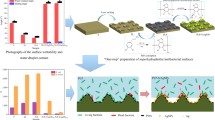Abstract
Aluminum and its alloys are widely used in almost all industries and for marine and medical applications. However, their surfaces are easily colonized by bacteria that form biofilms and corroded by chemical reactions. We report here a simple method to fabricate polyaniline/chitosan/zinc stearate superhydrophobic coatings on aluminum with a micro–nanosurface structure by polymerization of aniline and deposition of chitosan and zinc stearate coating. The fabricated coatings have been characterized by ATR-IR, XRD, FE-SEM, and EDX. The superhydrophobic surface shows the highest water-repellent property with contact angle of 150.7°, which is responsible for antiadhesion of bacteria, antiicing property, and excellent corrosion resistance of aluminum. The corrosion behavior of the coating in the 3.5% NaCl solution was investigated by EIS and potentiodynamic polarization. The efficacies of the different coatings against bacteria that are commonly encountered in marine (Desulfovibrio desulfuricans) and medical applications (Staphylococcus aureus and Escherichia coli) are demonstrated.
Graphical Abstract













Similar content being viewed by others
References
Martin, CR, “Membrane-based Synthesis of Nanomaterials.” Chem. Mater., 8 1739–1746 (1996)
Tiruvenkadam, N, Thyla, PR, Senthilkumar, M, Bharathiraja, M, Murugesan, A, “A Synthesis of New Aluminum Nano Hybrid Composite Liner for Energy Saving in Diesel Engines.” Energy Convers. Manag., 98 440–448 (2015)
Li, Y, Burstein, GT, Hutchings, IM, “The Influence of Corrosion on the Erosion of Aluminium by Aqueous Silica Slurries.” Wear, 186 515–522 (1995)
Rao, TS, “Combating Bacterial Colonization on Metals via Polymer Coatings.” Corros. Rev., 22 333–365 (2009)
Beech, I, Sunner, B, “Biocorrosion: Towards Understanding Interactions Between Biofilms and Metals.” J. Curr. Opin. Biotechnol., 15 181–186 (2004)
Feng, L, Song, Y, Zhai, J, Liu, B, Jiang, L, Zhu, D, “Creation of a Super Hydro Phobic Surface from an Amphiphilic Polymer.” Angew. Chem. Int. Edition, 42 800–802 (2003)
Kalaivasan, N, Syed Shafi, S, “Synthesis of Various Polyaniline/Clay Nanocomposites Derived from Aniline and Substituted Aniline Derivatives by Mechanochemical Intercalation Method.” E J. Chem., 7 1477–1483 (2010)
Narayanan, BN, Koodathil, R, Gangadharan, T, Yaakob, Z, Saidu, F, Handralayam, S, “Preparation and Characterization of Exfoliated Polyaniline/Montmorillonite Nanocomposites.” Mater. Sci. Eng. B, 168 242–244 (2010)
Baldissera, AF, Ferreira, CA, “Coatings Based on Electronic Conducting Polymers for Corrosion Protection of Metals.” Prog. Org. Coat., 75 241–247 (2012)
Tanveer, N, Mobin, M, “Anti-corrosive Properties of Poly(2-pyridylamine-coaniline-co-2, 3-xylidine) Terpolymer Coating on Mild Steel in Different Corrosive Environments.” Prog. Org. Coat., 75 231–240 (2012)
Nagels, GT, Winand, R, Weymeersch, A, Renard, L, “Electron Conducting Organic Coating of Mild Steel by Electropolymerization.” J. Appl. Electrochem., 22 756–764 (1992)
Sekine, I, Kohara, K, Sugiyama, T, Yuasa, M, “Syntheses of Polymerized Films on Mild Steels by Electro-Oxidation and Electroreduction and Their Corrosion Resistance.” J. Electrochem. Soc., 139 3090–3097 (1992)
Kamaraj, K, Karpakam, V, Sathiyanarayanan, S, Venkatachari, G, “Electrosysnthesis of Poly(aniline-co-m-amino benzoic acid) for Corrosion Protection of Steel.” Mater. Chem. Phys., 122 123–128 (2010)
Wei, Y, Hariharan, R, Patel, S, “Chemical and Electrochemical Copolymerization of Aniline with Alkyl Ring-Substituted Anilines.” Macromolecules, 23 758–764 (1990)
Chen, CX, Gao, YH, “Electrochemical Characteristics of Polyaniline Electro-Synthesized in the Presence of Neutral Red.” Mater. Chem. Phys., 102 24–30 (2007)
Rhazi, M, Desbrieres, J, Tolaimate, A, Alagui, A, Vottero P, “Investigation of Different Natural Sources of Chitin: Influence of the Source and Deacetylation Process on the Physicochemical Characteristics of Chitosan.” Polym. Int., 49 337–344 (2000)
Yalcınkaya, S, Demetgul, C, Colak, N, “Electrochemical Synthesis and Characterization of Polypyrrole/Chitosan Composite on Platinum Electrode: Its Electrochemical and Thermal Behaviors.” Carbohydr. Polym., 79 908–913 (2010)
Wallace, G, Smyth, M, Zhao, H, “Conducting Electroactive Polymer-Based Biosensors.” Trends Anal. Chem., 18 245–251 (1999)
Lundvall, O, Gulppi, M, Paez, MA, Gonzalez, E, Zagal, JH, Pavez, J, Thompson, GE, “Copper Modified Chitosan for Protection of AA-2024.” Surf. Coat. Technol., 201 5973–5978 (2007)
Alsabagh, M, Elsabee, MZ, Moustafa, YM, Elfky, A, Morsi, RE, “Corrosion Inhibition Efficiency of Some Hydrophobically Modified Chitosan Surfactants in Relation to Their Surface Active Properties.” Egypt. J. Petrol., 23 349–359 (2014)
Meruvu, H, Vangalapati, M, Chaitanya Chippada, S, Bammidi, S, “Synthesis and Characterization of Zinc Oxide Nanoparticles and Its Antimicrobial Activity Against Bacillus subtilis and Escherichia coli.” Rasayan J. Chem., 4 217–222 (2011)
Ning, T, Xu, WG, Lu, SX, “Fabrication of Superhydrophobic Surfaces on Zinc Substrates and Their Application as Effective Corrosion Barriers.” Appl. Surf. Sci., 258 1359–1365 (2011)
Yuan, SJ, Pehkonen, SO, Liang, B, Ting, YP, Neoh, KG, Kang, ET, “Super Hydrophobic Fluoropolymer-Modified Copper Surface via Surface Graft Polymerisation for Corrosion Protection.” Corros. Sci., 53 2738–2747 (2011)
Li, J, Liu, X, Ye, Y, Zhou, H, Chen, J, “A Simple Solution-Immersion Process for the Fabrication of Superhydrophobic Cupric Stearate Surface with Easy Repairable Property.” Appl. Surf. Sci., 258 1772–1775 (2011)
Escobar, M, Llorca-Isern, N, “Superhydrophobic Coating Deposited Directly on Aluminum.” Appl. Surf. Sci., 305 774–782 (2014)
Kwak, G, Seol, M, Tak, Y, Yong, K, “Superhydrophobic ZnO Nanowire Surface: Chemical Modification and Effects of UV Irradiation.” J. Phys. Chem. C, 113 12085–12089 (2009)
Qian, B, Shen, Z, “Fabrication of Superhydrophobic Surfaces by Dislocation-Selective Chemical Etching on Aluminum, Copper, and Zinc Substrates.” Langmuir, 21 9007–9009 (2005)
Song, JL, Xu, WJ, Lu, Y, “One-Step Electrochemical Machining of Superhydrophobic Surfaces on Aluminum Substrates.” J. Mater. Sci., 47 162–168 (2012)
Zaraska, L, Sulka, GD, Jaskuła, M, “The Effect of n-Alcohols on Porous Anodic Alumina Formed by Self-organized Two-Step Anodizing of Aluminum in Phosphoric Acid.” Surf. Coat. Technol., 204 1729–1737 (2010)
Owens, DK, Wendt, RC, “Estimation of the Surface Free Energy of Polymers.” J. Appl. Polym. Sci., 13 1741–1747 (1969)
Carre, A, “Polar Interactions at Liquid/Polymer Interfaces.” J. Adhes. Sci. Technol., 21 961–981 (2007)
Zinkevich, V, Bogdarina, I, Kang, H, Hill, MA, Tapper, R, Beech, IB, “Characterization of Exopolymers Produced by Different Isolates of Marine Sulfate Reducing Bacteria.” Int. Biodeterior. Biodegrad., 37 63–69 (1996)
Salsvagiona, HI, Miras, MC, Barbero, C, “Chemical Lithography of a Conductive Polymer Using a Traceless Removable Group.” J. Am. Chem. Soc., 25 5290–5296 (2003)
Kamaraj, K, Sathiyanarayanan, S, Muthukrishnan, S, Venkatacahari, G, “Corrosion Protection of iron by Benzoate Doped Polyaniline Containing Coatings.” Prog. Org. Coat., 64 460–465 (2009)
Jhansen, HD, Brett, CMA, Motheo, AJ, “Corrosion Protection of Aluminium Alloy by Cerium Conversion and Conducting Polymer Duplex Coatings.” Corros. Sci., 63 342–350 (2012)
Chakradhar, RP, Dinesh Kumar, V, “Water-Repellent Coatings Prepared by Modification of ZnO Nanoparticles.” Spectrochim. Acta, 94 352–356 (2012)
Sedaghat, S, “Synthesis and Characterization of New Bio Compatible Copolymer: Chitosan Graft Polyaniline.” Int. Nano Lett., 4 2–9 (2014)
Khan, R, Dhayal, M, “Chitosan/Polyaniline Hybrid Conducting Biopolymer Base Impedi Metric Immunosensor to Detect Ochratoxin-A.” Biosens. Bioelectron., 24 1700–1705 (2009)
Salavagione, HJ, Acevedo, DF, Miras, AC, Motheo, AJ, Barbero, CA, “Comparative Study of 2-Amino and 3-Aminobenzoic Acid Copolymerization with Aniline Synthesis and Copolymer Properties.” J. Polym. Sci. A Polym. Chem., 42 5587–5599 (2004)
Cansen, L, Fenghua, S, Jizhao, L, Huang, P, “Facile Fabrication of Superhydrophobic Cerium Coating with Micro-nano Flower-Like Structure and Excellent Corrosion Resistance.” Surf. Coat. Technol., 258 580–586 (2014)
Zhi-feng, L, Peng, W, Dun, Z, Yi, W, “A ZnO/Chitosan Composite Film: Fabrication and Anticorrosion Characterization.” Adv. Mater. Res., 153 1199–1202 (2011)
Raj, V, Mumjitha, M “Comparative Study of Formation and Corrosion Performance of Porous Alumina and Ceramic Nanorods Formed in Different Electrolytes by Anodization.” Mater. Sci. Eng. B, 179 25–35 (2014)
Mostafaei, A, Zolriasatei, A, “Synthesis and Characterization of Conducting Polyaniline Nanocomposites Containing ZnO Nanorods.” Prog. Nat. Sci. Mater. Int., 22 273–280 (2012)
John, S, Joseph, A, Joes, AJ, “Enhancement of Corrosion Protection of Mild Steel by Chitosan/ZnO Nanoparticle Composite Membranes.” Prog. Org. Coat., 84 28–34 (2015)
Wang, S, Feng, L, Jiang, L, “One-Step Solution-Immersion Process for the Fabrication of Stable Bionic Superhydrophobic Surfaces.” Adv. Mater., 18 767–770 (2006)
Thiemann, C, Brett, C, “Electrosynthesis and Properties of Conducting Polymers Derived from Amino Benzoic Acid and Aniline.” Synth. Metals, 123 1–7 (2001)
Ohsaka, T, Ohnuki, Y, Oyama, N, Katagiri, G, Kamisako, K, “IR Absorption Spectro Scopic Identification of Electroactive and Electroinactive Polyaniline Films Prepared by the Electrochemical Polymerization of Aniline.” J. Electroanalyt. Chem., 161 399–405 (2001)
Nunziante, P, Pistoia, G, “Factors Affecting the Growth of Thick Polyaniline Films by the Cyclic Voltammetry Technique.” Electrochim. Acta, 34 223–229 (1989)
Feng, LB, Che, YH, “Superhydrophobic Alumina Surface Based on Stearic Acid Modification.” Appl. Surf. Sci., 283 367–374 (2013)
Al-Qadhi, M, Merah, N, Matin, A, Abu-Dheir, N, Khaled, M, Youcef-Toumi, K, “Preparation of Superhydrophobic and Self-cleaning Polysulfone Non-wovens by Electrospinning: Influence of Process Parameters on Morphology and Hydrophobicity.” Polym. Res., 22 207–212 (2015)
Stern, M, Geary, AL, “Electrochemical Polarization I, A Theoretical Analysis of the Shape of Polarization Curves.” J. Electrochem. Soc., 104 56–63 (1957)
Siva, T, Kamaraj, K, Sathiyanarayanana, S, “Electrosynthesis of Poly (aniline-co-o-phenyl enediamine) Film on Steel and Its Corrosion Protection Performance.” Prog. Org. Coat., 77 1807–1815 (2014)
Wang, P, Zhang, D, Qiu, R, Hou, B, “Super-Hydrophobic Film Prepared on Zinc as Corrosion Barrier.” Corros. Sci., 3 2080–2086 (2011)
Mostafaei, A, Zolriasatein, A, “Synthesis and Characterization of Conducting Polyaniline Nanocomposites Containing ZnO Nanorods.” Mater. Int., 22 273–280 (2012)
Ohtsuka, T, “Corrosion Protection of Steels by Conducting Polymer Coating.” Int. J. Corros., 12 1–7 (2012)
Madhankumar, A, Rajendran, N, “Influence of Zirconia Nanoparticles on the Surface and Electrochemical Behaviour of Polypyrrole Nanocomposite Coated 316L SS in Simulated Body Fluid.” Surf. Coat. Technol., 213 155–166 (2012)
Phanasgaonkar, A, Raja, VS, “Influence of Curing Temperature, Silica Nanoparticles- and Cerium on Surface Morphology and Corrosion Behaviour of Hybrid Silane Coatings on Mild Steel.” Surf. Coat. Technol., 203 2260–2271 (2009)
Mansfeld, F, “Use of Electrochemical Impedance Spectroscopy for the Study of Corrosion by Polymer Coatings.” J. Appl. Electrochem., 25 187–202 (1995)
Huo, K, Zhang, X, Wang, H, Zhao, L, Liu, X, Chu, PK, “Osteogenic Activity and Antibacterial Effects on Titanium Surfaces Modified with Zn-incorporated Nanotube Arrays.” Biomaterials, 34 3467–3478 (2013)
Premanathan, M, Krishnamoorthy, K, Jeyasubramanian, K, Manivannan, G, “Selective Toxicity of ZnO Nanoparticles Toward Gram-Positive Bacteria and Cancer Cells by Apoptosis Through Lipid Peroxidation.” Nanomed. Nanotechnol. Biol. Med., 7 184–189 (2011)
Kompany, E, Mirza, H, Hosseini, S, Murphy, BP, Djordjevic I, “Polyoctanediol Citrate–ZnO Composite Films: Preparation, Characterization and Release Kinetics of Nanoparticles from Polymer Matrix.” Mater. Lett., 126 165–168 (2014)
Ferrari, M, Benedetti, A, Santini, E, Liggieri, L, Guzman, E, Cirisano, F, “Physico Chemical and Engineering Aspects Biofouling Control by Superhydrophobic Surfaces in Shallow Euphotic Seawater.” Colloids Surf. A Physicochem. Eng. Asp., 480 369–375 (2015)
Li, X, Zhang, K, Zhao, Y, Zhu, K, Yuan, X, “Formation of Icephobic Film from POSS-Containing Fluorosilicone Multi-block Methacrylate Copolymers.” Prog. Org. Coat., 89 150–159 (2015)
Wang, Y, Xue, J, Wang, Q, Chen, Q, Ding, JF, “Verification of Icephobic/Anti-icing Properties of a Superhydrophobic Surface.” ACS Appl. Mater. Interfaces, 5 3370–3381 (2013)
Bahadur, V, Mishchenko, L, Hatton, B, Taylor, JA, Aizenberg, J, Krupenkin, T, “Predictive Model for Ice Formation on Superhydrophobic Surfaces.” Langmuir, 27 14143–14150 (2011)
Acknowledgments
We acknowledge the major financial support from the Department of Science and Technology, New Delhi, India (DST-SERB, Ref. No.: SERB/F/7154/2013-14).
Author information
Authors and Affiliations
Corresponding author
Rights and permissions
About this article
Cite this article
Mohan Raj, R., Raj, V. Fabrication of superhydrophobic coatings for combating bacterial colonization on Al with relevance to marine and medical applications. J Coat Technol Res 15, 51–64 (2018). https://doi.org/10.1007/s11998-017-9945-2
Published:
Issue Date:
DOI: https://doi.org/10.1007/s11998-017-9945-2




